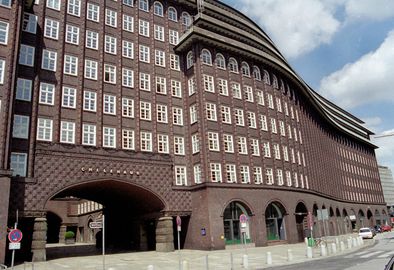

We're standing in front of a tall, impressive building made of dark-red brick. The top of the facade juts forward, like the prow of a huge ship, with stepped areas behind like the ship's deck. Long rows of columns extend to the left and right, which are decorated with sculptures of people and animals. Now step forward a little, and you can come into the building's courtyard – from where you can get a better handle on the building's extraordinary geometric construction. The building appears massive – it covers an area of six thousand square metres. The bricks in the facade create patterns which have different appearances according to how the sunlight strikes them. This building is called the Chile-Haus – named after the country, and not the hot pepper – and is beautifully illuminated at night, and appears almost even bigger than by day. The design of the building's interiors is also worth seeing – take a look at the exquisite hand-made details, including the copper door-handles and redwood wall panels.
The Chile-Haus is considered one of the symbols of business in Hamburg at the start of the 20th century. It was built in 1924 by the architect Fritz Höger for the Hanseatic business trader Henry Brassens Sloman.
The name Hanseatic goes back to the trade guilds which began from the 9th century onwards. Their ships operated on new trading routes – and in order to cut the possible risks of trade to a minimum, and protect themselves from the attacks of pirates, these European merchants consolidated themselves in a huge union. Particularly influential was the Hanseatic Union section in the north German city of Lübeck, which numbered more than 50 partner organisations in different ports of the North Sea. The Hansa organisation operated with its own currency, and with its own Board of Control – and was backed with huge capital sums. It could easily afford, for example, to commission new trading ships.
The Hanseatic merchant Henry Sloman left Hamburg while still young, and without a penny to his name. He returned only in his 60s, by which time he had amassed a tidy personal fortune through his trading activities – particularly through his business in the South American country of Chile. Deciding to do something for the city of his birth, he purchased five thousand metres of land – and five million bricks. The building went up in just two years – and Hamburg had a new attraction, in the so-called “Brick Expressionism” style. It was named after the country which had made Sloman's fortune. In 1983, the Chile-Haus was included in the UNESCO list of World Heritage Sites.
If you're lucky, you might meet a colourful street-trader near the entrance to inner courtyard of the Chile-Haus. He carries a home-made sign that looks it has come from the Middle Ages. He sells amazingly delicious home-made apple jam. His schedule is a little unpredictable, and there's no guarantee you'll see him – but if you do, we strongly suggest not missing the chance to try some jam.